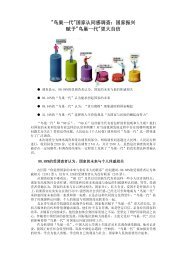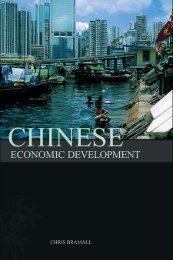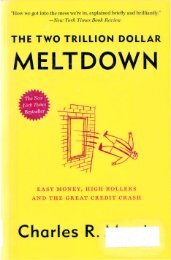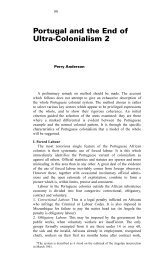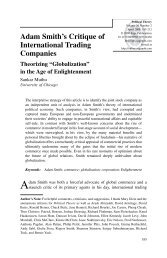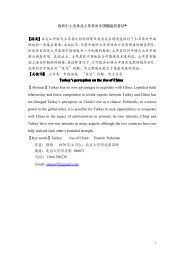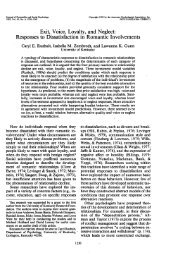Battle for China's Past : Mao and the Cultural Revolution
Battle for China's Past : Mao and the Cultural Revolution
Battle for China's Past : Mao and the Cultural Revolution
Create successful ePaper yourself
Turn your PDF publications into a flip-book with our unique Google optimized e-Paper software.
Great Leap Forward were encouraged to consolidate <strong>and</strong> develop<br />
fur<strong>the</strong>r. The issue of how to make <strong>the</strong> rural population part of an integrated<br />
development still faces China today. According to Wen (2005),<br />
even with <strong>the</strong> present rapid rate of industrialization <strong>and</strong> urbanization<br />
<strong>the</strong>re will still be 800 million people living in rural China by 2050.<br />
There<strong>for</strong>e, I would like to argue that <strong>the</strong> Great Leap Forward idea was<br />
not some kind of madness, but <strong>the</strong>oretically guided rationality.<br />
The economy in <strong>the</strong> <strong>Mao</strong> era<br />
MAO: THE KNOWN STORY<br />
There is plenty of evidence that supports <strong>the</strong> known story in which<br />
hundreds of millions of people were affected positively. The increase<br />
of life expectancy in <strong>the</strong> era of <strong>Mao</strong> alone, in <strong>the</strong> words of Williems<br />
(2005), has given an estimated 35 billion extra collective years of life<br />
to <strong>the</strong> Chinese people. Though living st<strong>and</strong>ards remained low, <strong>and</strong><br />
were <strong>for</strong> many at subsistence level, it is plain truth that except <strong>for</strong> <strong>the</strong><br />
Great Leap Forward Years of 1959 <strong>and</strong> 1960 <strong>and</strong> <strong>the</strong> <strong>Cultural</strong> <strong>Revolution</strong><br />
years of 1967 <strong>and</strong> 1968, Chinese economic growth was not only<br />
steady but also outpaced most developing countries. By 1976 China<br />
had laid down a sound industrial <strong>and</strong> agricultural base <strong>for</strong> an<br />
economic take off. These facts are proven <strong>and</strong> accepted by both<br />
Chinese <strong>and</strong> Western scholars in <strong>the</strong>ir macro studies (Meisner 1986,<br />
Lardy 1978, Rawski 1993, Chow 1985, Perkins 1985, <strong>and</strong> Field 1986)<br />
as well as micro case studies (Forster 2003, Bramall 1993 <strong>and</strong> Endicott<br />
1989). Even <strong>the</strong> Chinese official statistics released by <strong>the</strong> post-<strong>Mao</strong><br />
authorities who shout loud anti-<strong>Mao</strong> rhetoric of economic calamities<br />
cannot deny <strong>the</strong>se facts.<br />
One should be cautious in quoting claims by <strong>the</strong> post-<strong>Mao</strong> Chinese<br />
authorities that intend to denigrate <strong>the</strong> <strong>Mao</strong> era, so as not to fall into<br />
<strong>the</strong> trap that ‘it must be true since <strong>the</strong> Chinese <strong>the</strong>mselves say so’. The<br />
instinct that ‘<strong>the</strong> Chinese would not say things bad about <strong>the</strong>mselves<br />
unless <strong>the</strong>y were true’ does not work all <strong>the</strong> time. Foster’s case study<br />
of Zhejiang is a good example to illustrate this point. The post-<strong>Mao</strong><br />
authorities <strong>and</strong> elite intelligentsia in Zhejiang province condemn <strong>the</strong><br />
<strong>Cultural</strong> <strong>Revolution</strong> by stating in <strong>the</strong> literature that <strong>the</strong> it caused ‘grave<br />
losses to economic construction’ <strong>and</strong> that: ‘<strong>the</strong> leftist policies caused<br />
<strong>the</strong> gross output of agriculture over four successive years (1968–71) to<br />
be lower than <strong>the</strong> that of 1967.’ But if one looks into <strong>the</strong> details one<br />
finds that ‘Zhejiang experienced double-digit rise over <strong>the</strong> following<br />
five years from 1969 to 1973. These were of <strong>the</strong> impressive magnitude<br />
of 19.2 per cent, 16.2 per cent, 15.4 per cent, 10.2 per cent <strong>and</strong> 11.5 per<br />
cent’ (Forster 2003: 147). The <strong>Cultural</strong> <strong>Revolution</strong> did not ‘cause <strong>the</strong><br />
disaster to <strong>the</strong> provincial economy’ <strong>and</strong> <strong>the</strong>re was ‘a rapid growth of<br />
rural industry’ (Forster 2003: 148).<br />
[ 87 ]





